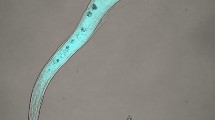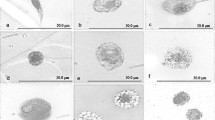Abstract
The Brugia pahangi infective larval response to jird serum was studied using an agar plate assay. Larvae placed onto the agar remained at the same place for 60 min. Once the larvae were stimulated by serum, more than 95% oriented towards the serum and reached it within few minutes. This larval response was inhibited by an activator of phosphodiesterase (imidazole), adenylate cyclase inhibitors (SQ22536 and MDL-12330A) and protein kinase A inhibitor. An inhibitor of phosphodiesterase (IBMX), an activator of adenylate cyclase (forskolin) and an membrane permeant analogue of cAMP (8-bromo-cAMP), caused a number of larvae to move out from the inoculation area towards the other zones. To our knowledge, this is the first report of a chemotactic response by B. pahangi larvae to host serum. We conclude that B. pahangi larvae show a chemotaxic response to host serum, and that cAMP and cAMP dependent protein kinase are involved in the signal transduction.







Similar content being viewed by others
References
Ash LR, Riley JM (1970) Development of sub-periodic Brugia malayi in the jird Meriones unguiculatus, with notes on infections in other rodents. J Parasitol 56:962–968
Coomans A, De Grisse A (1981) Sensory structures. In: Zuckerman BM, Rohde RA (eds) Plant parasitic nematodes. Academic Press, New York, pp 127–174
Dusenbery DB (1980) Behaviour of free-living nematodes. In: Zuckerman BM (ed) Nematodes as biological models. Academic Press, New York, pp 127–158
Dusenbery DB (1983) Chemotactic behaviour of nematodes. J Nematol 15:168–173
Ewert A (1967) Studies of the transfer of infective Brugia pahangi larvae from vector mosquitoes to the mammalian host. Trans R Soc Trop Med Hyg 61:110–113
Granzer M, Haas W (1991) Host finding host recognition of infective Ancylostoma caninum larvae. Int J Parasitol 21:429–440
Grewal PS, Wright DJ (1992) Migration of Caenorhabditis elegans (Nematoda: Rhabditidae) larvae towards bacteria and the nature of the bacterial attractants. Fundam Appl Nematol 15:159–166
Grewal PS, Gaugler R, Selvan S (1993) Host recognition by entomopathogenic nematodes: behavioral response to contact with host feces. J Chem Ecol 19:1219–1231
Jansson HB, Jeyaprakash RA, Damon J, Zuckerman BM (1984) Caenorhabditis elegans and Panagrellus redivivus: enzyme-mediated modification of chemotaxis. Exp Parasitol 58:270–277
Khlibsuwan W, Ishibashi N, Kondo E (1992) Response of Steinernema carpocapsae infective juveniles to the plasma of three insect species. J Nematol 24:156–159
Kozek WJ (1968) Unusual cilia in the microfilaria of Dirofilaria immitis. J Parasitol 54:838–844
McLaren DJ (1969) Ciliary structures in the microfilaria of Loa Loa. Trans R Soc Trop Med Hyg 63:290–291
Pace U, Hanski E, Salomon Y, Lancet D (1985) Odorant-sensitive adenylate cyclase may mediate olfactory reception. Nature 24:255–258
Roberts TM, Ward S, Chernin E (1979) Behavioral response of Schistosoma mansoni miracidia in concentration gradient of snail conditioned water. J Parasitol 63:849–853
Sklar PB, Anholt RRH, Snyder SHH (1986) The odorant-sensitive adenylate cyclase of olfactory receptor cells. Differential stimulation by distinct classes of odorants. J Biol Chem 261:15538–15543
Ward S (1973) Chemotaxis by the nematode Caenorhabditis elegans: identification of attractants and analysis of the response by use of mutants. Proc Natl Acad Sci U S A 70:817–821
Wright KA (1983) Nematode chemosensillia: form and function. J Nematol 15:151–158
Zuckerman BM, Jansson HB (1984) Nematode chemotaxis and possible mechanisms of host/prey recognition. Annu Rev Phytopathol 22:95–113
Acknowledgement
This work was supported in part by a Grant-in-Aid (no. 10670233) for scientific research from the Ministry of Education, Science and Culture of Japan. All procedures conformed to the guidelines of the Animal Care and Use Committee of Nagasaki University.
Author information
Authors and Affiliations
Corresponding author
Rights and permissions
About this article
Cite this article
Gunawardena, N.K., Fujimaki, Y. & Aoki, Y. Chemotactic response of Brugia pahangi infective larvae to jird serum in vitro. Parasitol Res 90, 337–342 (2003). https://doi.org/10.1007/s00436-003-0838-1
Received:
Accepted:
Published:
Issue Date:
DOI: https://doi.org/10.1007/s00436-003-0838-1




